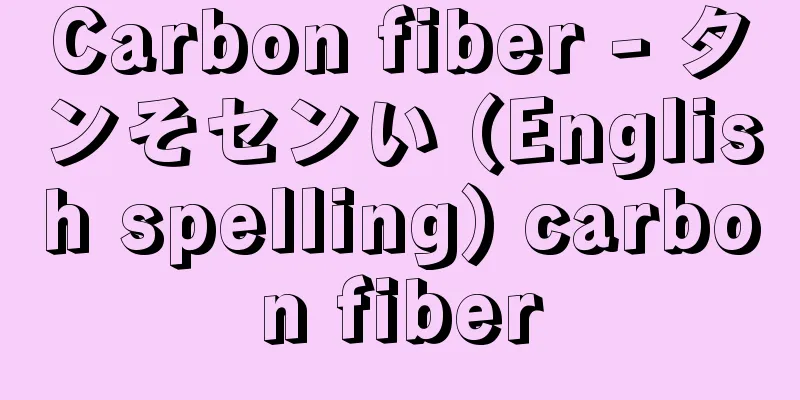Carbon fiber - タンそセンい (English spelling) carbon fiber

|
A type of carbonized fiber. Carbonized fiber is a general term for fibrous materials made by carbonizing organic fibers in an inert gas, and among these, those with a high degree of carbonization of 90-98% or more are generally called carbon fibers. The history of carbon fiber dates back to 1879, when it was used by the American Thomas Edison as the filament for the incandescent light bulb he invented, but it disappeared after the invention of tungsten wire. In 1960, the American Union Carbide Company developed a manufacturing method for carbon fiber from viscose rayon as a new material. However, this was used as a heat-resistant material, not as a structural material. After that, lightweight and ultra-rigid materials were required for space development, and since the 1970s, methods using polyacrylonitrile (PAN) fiber as a raw material have become mainstream. This PAN-based carbon fiber was invented in 1959 (Showa 34) by Akio Shindo (1926-2016) and others at the Osaka Industrial Technology Research Institute (one of the predecessors of the National Institute of Advanced Industrial Science and Technology) of the Ministry of International Trade and Industry (now the Ministry of Economy, Trade and Industry), and was highly praised overseas rather than in Japan. In addition, research on pitch-based carbon fibers made from petroleum or coal tar pitch is also progressing. [Hiroshi Kakiuchi] ManufacturingFirst, the raw fiber is produced and slowly heated in air at 200 to 300°C. For PAN-based fibers, this is called pretreatment, and for pitch-based fibers, it is called infusibility treatment. Both are mild oxidation treatments using air, and the oxidation causes intermolecular cross-linking, improving heat resistance and preventing melting during the subsequent firing process. During the firing process, carbonization and then graphitization occur. High-performance carbon fibers that are fully graphitized have a low specific gravity (1.76 to 1.91 for PAN-based fibers, 2.0 to 2.2 for pitch-based fibers) and high tensile strength and elastic modulus. The specific strength and elastic modulus, calculated by dividing these values by the specific gravity, are significantly higher than those of metals, which is a characteristic of carbon fibers. For practical use, continuous fibers are supplied in the form of yarns (single threads) consisting of several thousand single fibers (filaments) with a diameter of about 7 micrometers (μm, 1/1000 of a millimeter) for PAN-based fibers and about 10 micrometers for pitch-based fibers. The PAN-based fiber has a low carbonization yield of 40-50%, while the pitch-based fiber has a high yield of 85-90%. In terms of the fiber itself, the pitch-based fiber is said to have a slightly lower compressive strength than the PAN-based fiber. Due to differences in yield, the pitch-based fiber is slightly cheaper. [Hiroshi Kakiuchi] ApplicationsCarbon fiber is used as a reinforcing material for structural composite materials, taking advantage of its high specific strength and specific modulus of elasticity. It is mainly compounded with epoxy resin as a plastic and is used for a variety of applications, with future demand expected. Outside of Japan, it is used in military aircraft and aerospace equipment, while in Japan it is used in carbon shafts for golf clubs, tennis rackets, fishing rods and more. Japan boasts the world's highest quality and production volume of carbon fiber, and supplies high-quality products to countries around the world. At present, its price is somewhat high, and its electrical conductivity can be a drawback. [Hiroshi Kakiuchi] "Carbon Fibers and Composite Materials" by Kensuke Okuda, edited by the Society of Polymer Science (1988, Kyoritsu Publishing) " ▽ "Handbook for the Use of New Functional Fibers" edited by the Editorial Committee for the Handbook for the Use of New Functional Fibers (1988, Kogyo Chosakai)" ▽ "Activated Carbon Fibers" by Masayoshi Shimada (1990, Fuyuki Publishing)" ▽ "New Carbon" by Michio Inagaki (1990, Fuyuki Publishing)" ▽ "Fibers and Materials" edited by the Society of Materials Science of Japan (1991, Shokabo Publishing)" ▽ "On the Elements 3: Carbon's Seven Transformations" by Nobuo Ishizaki (1993, Kenseisha Publishing) ▽ "Interface Control and the Design of Composite Materials" by Fumio Ide (1995, Sigma Publishing)" ▽ "The World of New Frontier Fibers" by Tatsuya Motomiya and Kanji Kajiwara (2000, Nikkan Kogyo Shimbun)" ▽ "Murahashi Hisahiro et al., eds., "Repair and Reinforcement with Continuous Fibers - Carbon Fiber and Aramid Edition" (2000, Riko Tosho)" ▽ "Nakaoka Tetsuro, ed., "Postwar Japan's Technological Development - Imitation or Creation" (2002, Nihon Keizai Hyoronsha)" ▽ "Yamane Kazuma, 'The Age of Metal Colors 5' (Shogakukan Bunko)" [References] | | | | | | | | | | | |©Shogakukan "> Carbon fiber manufacturing process ©Shogakukan "> Chemical structure and carbonization process of PAN and pitch systems Source: Shogakukan Encyclopedia Nipponica About Encyclopedia Nipponica Information | Legend |
|
炭化繊維carbonized fiberの一種。有機系の繊維を不活性ガス中で炭化した繊維状物質の総称が炭化繊維であり、そのうちで炭化度が90~98%以上という高いものを一般に炭素繊維とよんでいる。 炭素繊維の歴史は、1879年にアメリカのエジソンによって、彼の発明した白熱電球用のフィラメントに用いられたのが最初であるが、その後発明されたタングステン線に追われて姿を消した。新しい材料としての炭素繊維は1960年にアメリカのユニオン・カーバイド社がビスコースレーヨンからの製造方法を開発した。しかし、これは構造材料としてではなく、耐熱材料として用いられた。その後、宇宙開発などのために軽量、超剛性の材質が要求されるようになり、1970年代以降、ポリアクリロニトリル(PAN(パン))繊維を原料とする方法が主流となっている。このPAN系炭素繊維を発明したのは、通商産業省(現、経済産業省)大阪工業技術試験所(現、産業技術総合研究所の前身の一つ)の進藤昭男(しんどうあきお)(1926―2016)らで、1959年(昭和34)であったが、日本でよりもむしろ海外で高く評価された。さらに、石油またはコールタールピッチを原料とするピッチ系の炭素繊維の研究も進んでいる。 [垣内 弘] 製造まず原料繊維を製造し、これを200ないし300℃の空気中でゆっくり加熱する。PAN系繊維ではこれを前処理、ピッチ系では不融化処理とよぶ。ともに空気による軽い酸化処理であり、酸化によって分子間架橋がおこり耐熱性が向上し、次の焼成工程の際の溶融防止などの役割を果たす。焼成処理で炭化に続いて黒鉛化がおこる。 黒鉛化が十分に進んだ高性能炭素繊維は比重が小さく(PAN系で1.76~1.91、ピッチ系では2.0~2.2)、引張り強さや弾性率が大きい。これらの値をその比重で割り算した比強度や比弾性率が金属に比べて著しく高いことが炭素繊維の特徴である。実際の使用にあたっては、連続繊維はPAN系で直径約7マイクロメートル(μm。1ミリメートルの1000分の1)、ピッチ系で約10マイクロメートルの単繊維(フィラメント)を数千本束ねたヤーン(単糸)の形で供給される。 PAN系は炭素化の収率が40~50%と低いのに対し、ピッチ系は85~90%と高いのが特徴である。また繊維自体についてはピッチ系がPAN系に比べて圧縮強度がすこし低いといわれている。価格は収率の相違などからピッチ系のほうがすこし安価である。 [垣内 弘] 用途炭素繊維は、その比強度と比弾性率の大きなことが利用されて構造材料用の複合材料の強化材として用いられている。おもにプラスチックとしてエポキシ樹脂との複合化が行われ、各種用途に用いられ、また将来の需要が期待されている。外国では軍用機や航空宇宙機器用器材などに用いられており、日本ではゴルフクラブのカーボンシャフト、テニスラケット、釣り竿(ざお)などに用いられている。日本の炭素繊維は世界一の品質と生産量を誇り、高品質のものを世界各国に提供している。いまのところ価格がやや高いこと、また電気を通すという特徴が欠点となることもある。 [垣内 弘] 『奥田謙介著、高分子学会編『炭素繊維と複合材料』(1988・共立出版)』▽『新機能繊維活用ハンドブック編集委員会編『新機能繊維活用ハンドブック』(1988・工業調査会)』▽『島田将慶著『活性炭素繊維』(1990・冬樹社)』▽『稲垣道夫著『ニューカーボン』(1990・冬樹社)』▽『日本材料科学会編『繊維と材料』(1991・裳華房)』▽『石崎信男著『元素をめぐって3 炭素は七変化』(1993・研成社)』▽『井手文雄著『界面制御と複合材料の設計』(1995・シグマ出版)』▽『本宮達也・梶原莞爾著『ニューフロンティア繊維の世界』(2000・日刊工業新聞社)』▽『村橋久弘ほか編著『連続繊維による補修・補強――炭素繊維・アラミド編』(2000・理工図書)』▽『中岡哲郎編著『戦後日本の技術形成――模倣か創造か』(2002・日本経済評論社)』▽『山根一眞著『メタルカラーの時代5』(小学館文庫)』 [参照項目] | | | | | | | | | | | |©Shogakukan"> 炭素繊維の製造工程 ©Shogakukan"> PAN系とピッチ系の化学構造と炭化過程 出典 小学館 日本大百科全書(ニッポニカ)日本大百科全書(ニッポニカ)について 情報 | 凡例 |
Recommend
Yamato Dance - Yamato Dance
Also written as Yamatomai or Wamai. A uniquely Jap...
《Kairokou》
…In the 20th century, American poet EA Robinson a...
Evaporite - Evaporite
Rocks formed when water from an ocean or lake (esp...
Filamentous pollen - Itojoukafun
...The genera Zostera, H. difficile (Hydrocharis ...
Iko Myoan - Iko Myoan
Year of death: December 3, 10 (January 2, 1568) Ye...
Ashikubo River
...The length of the main river is 51 km, and the...
Structural approach
...However, the occupation of the Allied forces, ...
Harmony Society
A Lutheran community established in Pennsylvania i...
Mediastinitis
Mediastinal disease is a condition that affects t...
American President Lines
An American liner company. APL is an American abbr...
Village head - Gocho
〘Noun〙① Under the ritsuryo system, an official in ...
Blue fish - Aomono
〘Noun〙① A green vegetable . By extension, a genera...
Heinrich Wittenweiler
A Swiss poet of the late Middle Ages. Also known a...
Hellas
…In ancient Greek it was Hellas, in modern Greek ...
British Bibliographical Society
... Because the form of a book is unique to each ...


![Otobe [town] - Otobe](/upload/images/67cb1febdf2bc.webp)






